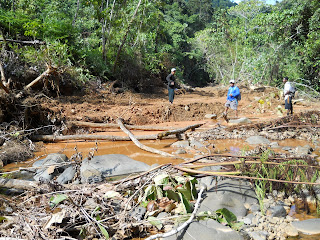The more than 186,031.6998 hectares of mountain land being mined or 13.88% has resulted to various environmental damage. Areas near mining concessions are easily flooded because of the increase in siltation. Agricultural production and fishing have decreased.
According to the Caraga Millenium Development Goals‐2007, about 1.2 million hectares or 62 percent of the region’s land area is within the watershed. These areas support irrigation systems, livelihood, transportation route for the watershed occupants and source of household and industrial water for the rural and urban areas. The presence of extractive companies has destroyed these watershed areas.
Floods
Most typhoons pass by Caraga particularly Surigao del Norte as they enter the country. With the destruction of forests, many areas in the region has become easily flooded. In February 2006, flooding resulted in the death of 13 persons. Damages to infrastructure alone reached P296 million while crop damages reached P50,689,567.00.
Most affected were areas in Surigao del Sur, Butuan City, municipalities of Esperanza and San Francisco, Agusan del Sur and Las Nieves and Jabonga in Agusan del Norte. In January of 2007 five people died by drowning during floods. Flood victims reached to 193,347 persons or about 41,861 families. There were 255 barangays affected by the flood particularly in the provinces of Agusan del Norte, Agusan del Sur, Surigao del Sur and the cities of Surigao and Butuan.
Since January 2009 there had been eight persons killed while 68,000 persons fled their homes because of flooding in different parts of the Caraga region. In 2009 at least 68,696 people were forced out of their homes when flashfloods hit 341 barangays in 34 towns and four cities in the region in January. 13 towns in Agusan del Sur were affected by floods, eight towns in Agusan del Norte, four in Surigao del Norte, four in Surigao del Sur and five in Province of Dinagat Islands including cities of Butuan, Surigao, Bayugan, Tandag and Bislig.
The report said floods destroyed 249 houses in Surigao del Norte, 190 in Agusan del Norte, 23 in Surigao del Sur and nine in Agusan del Sur. Reports from Agusan del Sur said some 4,725 people evacuated when the Agusan River overflowed following continuous rains. The Provincial Disaster Coordinating Council (PDCC) reported that of the 160 barangays affected by flashfloods.
As of June 2008: Caraga
MPP: 103,643.25
EP: 12,388.4498
Coal Production and Exploration: 70,000
TOTAL: 186,031.6998
% of Total Forest land: 1,339,800: 13.88%
% of Total Land Area: 1,884,697: 9.87%
Mining Caraga 21 Landslides The depletion of trees has resulted to landslides. There are 186 high landslide prone areas and 234 moderate landslide susceptible sites in the region. Most of these landslide prone areas are situated in mining and logging areas or former logging and mining sites now abandoned.
Industrial Waste Contamination:
In Surigao del Norte, industrial waste and mine tailings are being dumped indiscriminately from open pits and tailings ponds of gold mining operations in the Hinatuan Passage. An open‐pit chromite mine in Claver also caused heavy siltation of rivers. Because of indiscriminate dumping of mine wastes, 1,639 damage claims were filed and processed by the DENR from 1990‐1994. The DENR has issued only a few minor citations against these operations; however, local grassroots
action was able to suspend some mining in 2000.
In Agusan del Norte, gold mining at commercial and small scale is prevalent in Cabadbaran, Santiago, Tubay, and Jabonga. Mine tailings are dumped in rivers such as the Kalinawan River, draining into the Mindanao Sea and causing
siltation of the coastal areas. Mining operations in San Roque, Kitcharao are also polluting the headwaters of the Lambug River. Ongoing mineral extraction activities are mostly smallscale operations, including 15 mining permits as well as illegal miners in the gold rush area in East Morgado, Santiago. The same is happening in Barobo, Surigao del Sur. There have been reports of fish kills in rivers and lakes in Barobo and Lianga. Birth defects have been reported in Barobo communities where Mining Caraga 22 cyanide and mercury are used in gold mining and processing have contaminated bodies of water and soil.
Mining at its present scale and practice has brought massive environmental and human damage. With the government’s push for the entry of more mining companies and related industries, the destruction of nature will be greater and will come at a faster rate.
In 2013, the Sumitomo Nickel Smelting and Processing Plant in Claver, Surigao del Norte will be operational. As it starts its operations in the region, it will shutdown the same plant in its home country because of the environmental damage it had done. Mineral smelting and processing plants will result in the contamination and loss of water sources and contamination of air. Industrial plants emit chemical gases which will be absorbed by the atmosphere. These
chemicals can travel for thousands of kilometers and comes down in the form of rain, fog or dew. Once it reaches the
ground, the acidity in the substance can harm and even destroy both natural ecosystems and cause diseases. Acid rain
moves easily, affecting locations far beyond those that let out the pollution.
